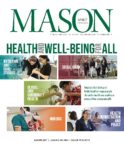When Kariann Fuqua began work in summer 2012 as the university’s first curator, her job began with something of a scavenger hunt.
While George Mason University has collected artwork for years, the collection had never been a formal one, and documentation on what the university owned was scattered across departments. Step one for Fuqua was to create a comprehensive inventory of Mason-owned works of art.
Sometimes, she had little more to go on than a memo noting that a piece had been hung in someone’s office. Even a year into the project, she still gets the occasional call from someone who finds something in a closet or, in one case, behind a file cabinet during an office move.
“It was actually valuable work,” she says of the item from the call. “It was on my list of things to find, so that was very helpful.”
Among the inventoried items is a substantial African art collection that comprises about 150 pieces, and a number of Salvadore Dalí prints. The university also owns a group of prints by Chilean artist Roberto Matta, as well as some plaster casts donated to Mason by the Metropolitan Museum of Art in New York.
One item that intrigued Fuqua was an artist book made in the 1960s by Walasse Ting, who convinced several of his contemporary pop artists—Lichtenstein, Warhol, and Rauschenberg among them—to make prints for the book. Mason has one of the 40 original artist copies. Despite her research, Fuqua says it is a mystery how the book came to the university. One of the book’s donors is deceased and the other person involved is very elderly, which has hindered her efforts to learn the piece’s history with Mason.
“Somewhere down the line, someone would have had to know one of the artists,” she says. Learning the provenance, or ownership history, of pieces in the collection has been a large part of her inventory, she says.
Fuqua’s attention is now turning to care and preservation of items in the collection. This effort requires space for adequate storage and preservation work, as well as a budget to fund efforts. “When you take on the responsibility of owning objects, you have to consider the cost of preserving them and keeping them in a condition that complies with professional standards,” she says.
This task will be the purview of the university’s newly formed Art Collection Advisory Committee, which will review proposals and provide recommendations on matters related to the collection. This responsibility includes accessioning and deaccessioning artwork, commissions, and sites for installations, as well as accepting gifts and bequests of artwork. The group includes representatives from the School of Art, Department of History and Art History, and the offices of Regional Campuses, Facilities, and University Development. The group was established following the university’s adoption of a formal collection management policy.
“The purpose of a university art collection is to provide a resource for research, teaching, and exhibition,” says Fuqua. “The Art Collection Advisory Committee is currently establishing a mission for the collection and its additional acquisitions to ensure that the art purchased or gifted can be of greater use to educate students and be a resource for future scholarship.”


No Comments Yet »
Leave a comment